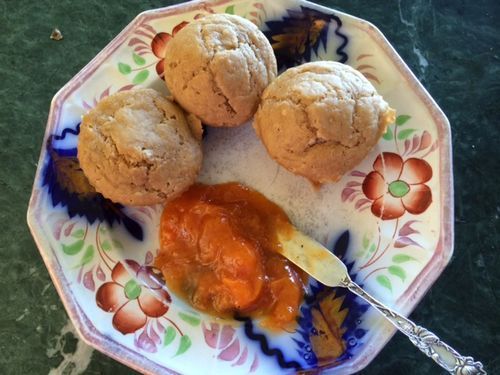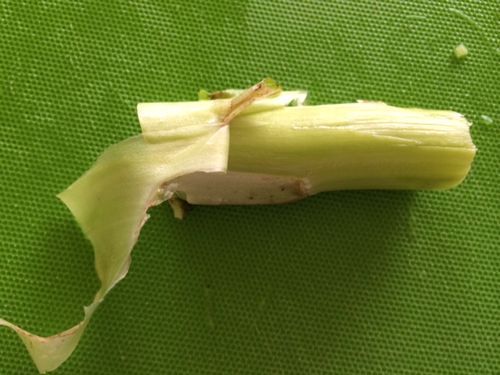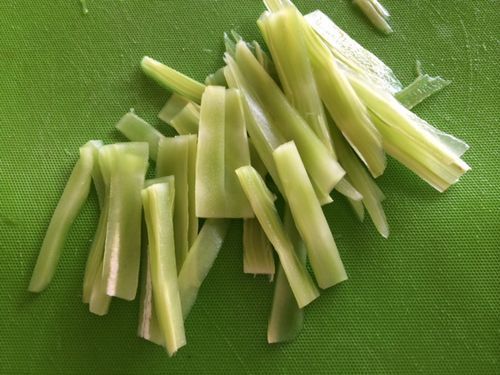Ruth Reichl's Blog, page 23
August 11, 2014
Odd Old Recipes
Roaming around a used book sale this weekend, I came upon this irresistible tome:
First printed in 1986, the edition I have is from 1999; it's the 28th printing!
It's filled with all manner of wonderful information, like how to make Grit Wurst out of a hog's head, cream-fry a squirrel, and roast an antelope. There must be a dozen different recipes for kraut. I particularly like instructions for a "chemical garden" made of coal, to replace the flowers you can no longer afford for your table. ("Into a nice large glass bowl put 2 or 3 piece of good sized coal. Pour 2 T. each of water, bluing and salt over it. Let stand a day and then add 2 more T. salt and water; add 3 drops of mercurochrome on each lump. It will form interesting growth formations both attractive and colorful.")
Can you still buy mercurochrome?
I keep leafing through the book, fascinated by these recipes; there are so many I've never seen before, like "Dandelion Dinner," and "Grot." (Grot is essentially a very thinned out Bechamel, served in big bowls as a soup supper.)
But the recipe I couldn't resist was this one:
Xtra Light Beer Muffins
2 cups sifted flour
3 t baking powder
1/2 t salt
4 T cold shortening, cut into the above
3 T sugar
1 can beer, can be warm and stale.
Drop in muffin tins or roll out, knead and cut. Bake at 375 until browned.
(The batter was fairly loose, and it's hard to see how it could possible be made into biscuits without adding considerably more flour. The recipe makes a dozen muffins, which I baked for about 25 minutes.)
I used dark beer, which is what I had on hand. The flavor is pleasantly malty, a lovely contrast to the apricot jam I spread on the warm muffins.
I've certainly encountered better muffins, but I don't think I've ever met a lighter one. And they're certainly simple to make: I threw them together in less than five minutes.
August 10, 2014
A Note on Aging Beef
I really love the taste of aged beef. I recently ordered dry-aged ground beef from the wholesale butcher, DeBragga (they sell meat to the likes of Daniel Boulud, Jean-Georges and Tom Colicchio), and it made the most wonderful burgers. They had that deeply complex, funky flavor you only get when beef is beautifully aged.
The problem: Dry-aging beef is extremely expensive. Unlike wet-aged beef (which is aged in cryovac), air-drying shrinks the beef, leaving the butcher with less to sell. And because they have to cut off the outside of the meat, there’s a serious amount of waste.
So when I read Nathan Mhyrvold’s trick for aging steak at home, I had to try it.
The method is simple: you buy a couple of inexpensive (not prime, not aged), boneless rib eye steaks, about 3/4 of a pound each, cut an inch thick. You put the steaks in a plastic bag, add a tablespoon and a half of Thai fish sauce, squeeze out the air, and put the packages in the refrigerator.
Three days later you remove the meat from the bag, wrap each steak in a double layer of cheesecloth (I actually used a single layer of a thicker Japanese cloth intended for marination), put the wrapped steaks on a rack and leave them in the refrigerator for 3 more days.
When I took the steaks out of their bloody wrappers they were enormously changed. They were dryer, denser and darker. I let them sit for half an hour, sprinkled them with salt, then cooked them in a very hot cast iron pan for three minutes a side (leave them another minute a side if you like your meat medium-rare). I put them on a cutting board, left them to rest for five minutes, and took them to the table.
They were, without any doubt, the best cheap steaks I’ve ever cooked. The process had drawn the liquid from the meat, and concentrated the flesh. They cooked beautifully, with a terrific sear.
But they did not taste like aged meat; they had none of that rich almost nutty flavor you get from meat that’s been left to hang. My guess is that there’s just no way to cheat the process.
Will I do this again? Definitely. Will I continue to splurge - every once in a while - on well-aged beef? Definitely.
August 9, 2014
Things I Love
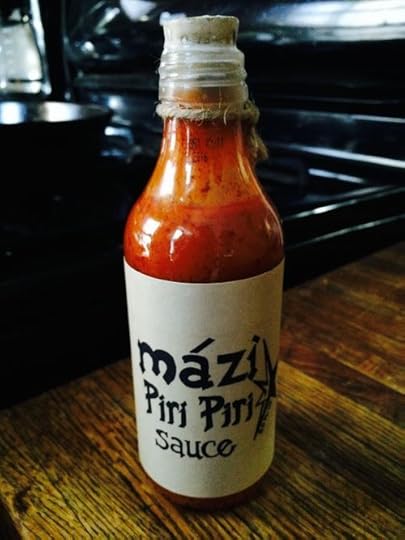
I'm always looking for great hot sauces, but this one..... is really wonderful. It's becoming so popular that the hand-made sauce is increasingly hard to find in stores. Fortunately, you can order Piri Piri sauce directly from the maker.
Piri is the swahili word for pepper, in this case, an African bird's eye chili.
Aged in old whisky barrels, Piri Piri is lightly smoky, incredibly complex, with a nice lemony brightness. I end up using it on every savory thing. It's fantastic splashed onto eggs, and stirred into mayonnaise it makes every sandwich better. I love it in black beans. And as a marinade... well, try it for yourself.
August 6, 2014
A Few Gems from Old Gourmet, Circa 1941
Reading old magazines is so endlessly fascinating, I can't help passing some of this on. These nuggets (some truly appalling), are from the first six issues of Gourmet.
In some cases the articles speak to how openminded Americans were when it came to what they considered edible back in the forties. They were happily devouring offal and foraged foods - and they were crazy for turtle. On the other hand, their appreciation of foods eaten in any continent other than Europe and America was almost nonexistent. The Japanese admiration for raw fish, for example, was considered a "curse." As for women... well, read on.
January 1941
Introducing the magazine:
“The art of being a gourmet has nothing to do with age, money, fame or country. It can be found in a thrifty French housewife with her pot-au-feu or in a white-capped chef in a skyscraper note. But wherever it exists, the practitioner of this art will have the eye of an artist, the imagination of a poet, the rhythm of a musician, and the breadth of a sculptor. That is the subtle amalgam of which the true gourmet is compounded.”
February 1941
The Last Touch - French sauces
“The trouble with giving advice about sauce-making is that every experienced cook is likely to have his or her own special difficult. Your own sauce weakness may be injecting the right delicate seasoning, somebody else may fall down in consistency, while another poor wretch is always having his or her sauces curdle. How is even the best-intentioned advice-giver going to find one piece of wisdom that will cover all these emergencies? It’s like trying to tell a hundred homely girls in one sentence what’s the matter with them and what they had better do about it.”
March 1941
“Terrapin comeback”
“The first way is to kill the terrapin by giving it a blow on the head, then chop off the head and suspend the turtle to let it bleed. Scald the whole turtle in a kettle of boiling water for about 5 minutes. Now remove the outer scales, and the dark skin of the fleshy parts. Then turn the terrapin on its back and cut down the center of the undersell. Discard entrails, heart, sandbag, gall, head, and the nails from the feet.”
April 1941
Food Flashes
...a new egg noodle maker in the E. 50s, a cheese biscuit maker with a small factory in Forest Hills, Long Island duck farms, a new store selling British dried herbs and teas, a delicious canned tripe available on Lexington in the 70s, a fine-grained Polish-style ham being made in Chicago, and (amazing) frozen cocktail sandwiches.
The Last Touch
Talks about how men have a keener sense of smell than women: “They make, therefore, the best chefs. They know taste, and taste’s the thing in sauce-making.”
May 1941
Eating around the world
“The principal curse of the Japanese diet, after the incessant rice, is the raw fish which is an alleged national delicacy. One final horror remains. It is the rice wine of the country, sake, a stomach-curdling stuff which I always found unpalatable and indigestible.”
“The Arabs of Northern Africa have a similar dish, made, however, with sheep or goat. They wrap the chunks of meat in a cooked porridge of wheat or millet, and eat the entire mess with their fingers. As I recall it, this not altogether aesthetic arrangement is labeled couscous."
Food Flashes
“Fiddlehead, a common colonial day pot herb and still a favorite green in the kitchens of Maine, is being given a second year trial this month in markets and hotel dining rooms of New York City. Though Maine housewives will pickle fiddleheads, Gourmet recommends serving them ala hotel chefs on toast with brown butter sauce."
“Paradise nuts from the Amazon Valley are for sale in Grand Central Terminal. We tried one on a favorite squirrel in Central Park. He had never met a paradise nut, but he knew what to do with it.”
June 1941
Food Flashes
Smoked turkeys, more American cheeses, bottled cocktails so that women can impress their men by “making cocktails,” a business that will send your soldier a coconut cake and a whole roasted chicken, pheasant from Oregon, different Virginia hams.
August 5, 2014
Beautiful Cold Soup
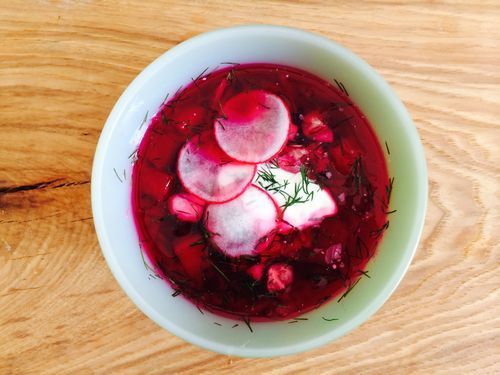
Now that we’re in cold soup season, everyone’s throwing gazpacho ideas around. In the mood for something different, I began thinking about the borscht my Russian grandfather was addicted to. He liked it hot, but wouldn’t it be great - and gorgeous - served cold?
This is everything you want in a cold soup: slightly sweet and lightly sour, it has a sturdy simplicity. There are so few ingredients that the flavor of the beets comes singing through. It feels great in your mouth, and when you top this beautiful soup with soft chunks of lightly boiled eggs and crisp cubes of cucumber, you get a whole new range of textures. I can’t think of a more appealing summer lunch.
Cold Borscht for Six
4 medium-sized beets, peeled and quartered
1 or 2 medium waxy potatoes, roughly diced
juice of 1 1/2 lemons
1 teaspoon apple cider vinegar
salt
pepper
Garnish:
diced cucumber
2-3 hardboiled eggs
Dill
Sour cream
Bring ten cups of water to a boil.
Peel and quarter 4 fresh beets (wear rubber gloves if you don’t want your hands to glow for the rest of the day), and add them to the pot. When the water comes back to a boil, turn down the flame and cook over medium-low heat for 20 minutes, or until a fork can easily pierce a beet’s surface.
Using a slotted spoon, remove the beets from the pot. Wearing your rubber gloves, shred them on the large holes of a grater and put them back into the pot along with the diced potatoes. Cook for another 12 minutes over medium low heat, until the potatoes are just lightly toothsome.
Add the lemon juice and apple cider vinegar. Add salt and pepper to taste.
Allow the soup to cool, then put into the refrigerator for several hours to allow the flavors to mingle and get to know each other.
Serve garnished with cucumber, freshly chopped dill, pieces of hardboiled egg and dollops of sour cream.
If you stir the sour cream completely in, you get this vivid sunset of a soup.
August 3, 2014
Everything Old is New Again: Take Two
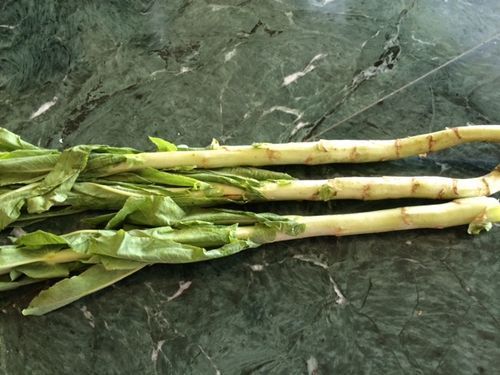
Researching the Gourmet memoir, I keep encountering such surprising little tidbits I can't resist passing them on.
When I wrote about celtuce a couple of weeks ago, I got so many questions about this Chinese stem lettuce, and so many requests for recipes. Clearly it's a vegetable that's completely new to Americans.
Or so I thought. But then I came upon this, from an early issue of Gourmet Magazine.
From Food Flashes April 1942
"Celtuce" is a new vegetable announced this spring by the W. Atlee Burpee Company, seed growers of Philadelphia...The seeds of this strange plant were sent to David Burpee three years ago by a friend, young missionary Carter D. Holton, located in Shun Wa Kansu near the Tibet border. "Here's a new vegetable for you to try on your farms," Dr. Holton wrote. "The Chinese think it's wonderful. They eat the young leaves raw, and when the plant matures, the stalks are peeled of their tough outer skin and heart part is used like celery or asparagus...."
The article talks about how farmers in Pennsylvania, California, and Arizona are growing this new vegetable. And in 1942, for the first time, seeds were available for home gardeners; price, 15 cents a packet...
"..Celtuce vinaigrette was served this spring at the festive dinner Lucius Boomer, president of the Waldof-Astoria, gives annually to the hotel and night club managers of New York City. This dinner is always the best that the Waldorf knows how to prepare, and that celtuce made the menu says a lot for its goodness."
This is celtuce, partly peeled.
And this is celtuce, peeled, sliced and par-boiled, ready to be stir-fried.
The question is: what happened? Why did celtuce disappear from America for the next 70 years? I'm going to try to find out.....
August 1, 2014
A Recipe from Gourmet's First Issue
This is from The Last Touch
No wonder people reverted to those sticky bottled orange salad dressings.....
A real French dressing, well deserving the name, is made as follows:
Put a gill (1/2 standard cup) of vinegar into a quart bottle with 2 1/2 generous tablespoons of salt, 1 of dry mustard (optional) and 1 1/2 teaspoons of pepper. Now, with a darning needle, string a clove of garlic on a long thread, drop the garlic into the vinegar and let the end of the thread dangle outside. Cork the bottle and let it stand for a week, shaking daily. At the end of that time, fish the garlic out and fill the bottle about three-quarters full of good olive oil. Shake thoroughly and taste.
July 31, 2014
Peach, Blueberry, Raspberry Pie
The fruit has been fantastic this year. The peaches have real flavor, and I've never had better blueberries than the local ones I bought yesterday. As for raspberries.... they're springing up all along the road.
Made the best pie last night, using the fruit I happened to have on hand. I liked the result so much that I just had to write the recipe down.
Peach, Blueberry and Raspberry Pie
all butter pie crust (recipe below)
4 ripe peaches
1 pint blueberries
1/2 pint raspberries
juice of half a lemon
1 1/2 tablespoons cornstarch
4 tablespoons sugar
Peel the peaches by blanching them in boiling water for 15 seconds or so and then running them under cold water. The skins will slip right off. Slice them into a bowl, being sure to capture all the juice.
Add the blueberries.
Stir the cornstarch into the sugar and stir the mixture into the fruit. Add the lemon juice and give it another stir.
Preheat oven to 400 degrees.
Spoon the fruit into a prepared pie shell. Cover with top crust, crimp the edges, cut slits into the middle of the pie and bake in hot oven for about an hour, until the crust is golden.
(Probably wise to put a sheet of aluminium foil beneath the pie when you put it in the oven; mine spilled over a bit at the end.)
Allow to cool before serving.
I don’t often make an all-butter crust, but for some reason I did. I found this dough so easy to work with - and so delicious - I can’t wait to do it again.
Wonderful All Butter Pie Crust for a Double Crust Pie
2 ½ cups all-purpose flour
1 teaspoon salt
1 tablespoon sugar
1/2 pound very cold unsalted butter, cut into ½ inch cubes
8-12 tablespoons ice water
Pulse the flour, salt, and sugar in the bowl of a food processor.
Add the butter cubes to a food processor and pulse until the mixture looks like small peas. Sprinkle 1/2 cup of the ice water over the mixture, pulsing until the dough begins to hold together, about 10 seconds. If it doesn’t hold together, slowly add a bit more ice water.
Turn the dough out and form two disks. Wrap each one in wax paper and refrigerate for an hour.
Remove the dough from the refrigerator and allow it to warm just until it's pliable, about 15 minutes. Roll the first disk out on a floured surface, fit into a deep 9 inch pie pan and refrigerate for 15 minutes. Roll the second disk out, wrap it in plastic and refrigerate that as well.
July 30, 2014
Everything Old is New Again
I've been working - finally - on my memoir of the Gourmet days, and the other day I found myself trolling through the magazine's very first issue.
Mostly it's a testament to how much things have changed. But then I came upon this.....
"Food Flashes" by Clementine Paddleford
“Come the last, mad midnight of 1940, when the bells are belling and the crowds are yelling, let smoke snacks bombard the senses. America has gone smoke crazy. Deep within us all persists a natural craving for the taste of wood smoke, That yearning is a heritage harkening back millions of generations, perhaps, to some dim memory from the paleolithic age when the first true men ate meat roasted over a forest fire. Now the craving is easily satisfied. That leathery smokehouse smell is getting its dark perfume into every kind of food.
For the holiday party may we suggest a smoked suckling pig. Serve his brown majesty kneeling on a parsley bed. His quizzical eyebrows are of lemon peel, his eyes are slices of stuffed olive, the apple in his mouth, a rosy lady apple. Ornamental is the word for this hickory-smoked sweet morsel, the average weight seven pods for around $5 at R.H. Macy’s.
Then smoked turkeys, smoked oysters, smoked Wisconsin cheese, smoked salt..
I like the idea of the smokehouse smell being "leathery." And I very much like the price: all you can hold for five bucks.
July 27, 2014
Aromatic Project for a Rainy Afternoon
Caramel Bourbon Peaches
Peel two ripe peaches by blanching them in boiling water for about 15 seconds and then running them under cold water; the skins should slip right off. Cut each one into eighths and put them into a bowl. Pour in a couple of tablespoons of good bourbon and swish them around.
Put a half cup of sugar in a heavy skillet and cook over low heat until it begins to liquify. Cook it, without stirring, swirling the pan occasionally, until it turns a deep golden color - about 5 minutes. Add the bourbon-soaked peaches and a couple tablespoons of cream and watch it hiss angrily, spitting at you and seizing up. Don’t worry; this fit will end, and if you stir it once in a while it will all soften in about 5 minutes, leaving you with tender caramelized peaches.
Spooned hot, over cold vanilla ice cream, this will make you very happy.
Ruth Reichl's Blog
- Ruth Reichl's profile
- 2980 followers


